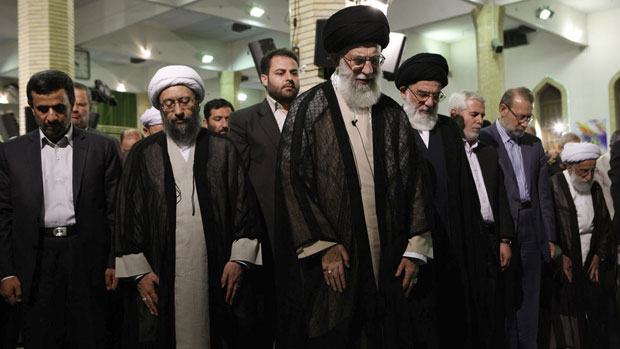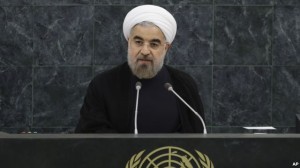A full version of this article, co-written by Scott Lucas and Joanna Paraszczuk, will appear as a chapter in a book, edited by Michel Makinsky and published in January.
Can the myth of “resistance” survive after Rouhani’s election, or must it adapt itself if the narrative of the Islamic Republic as a unique counter to the “West” is to remain unshaken? Ironically, its greatest ally may come from outside Iran, in the form of the US-led sanctions.
For more than a year, Iran has operated under the ideology of the “resistance economy”, a concept declared by the Supreme Leader in an August 2012 speech.
In that speech, Ayatollah Ali Khamenei urged then-President Mahmoud Ahmadinejad to adopt what he termed a “resistance economy”, laying out twelve key “resistance economy” principles, including that Iran’s indigenous production should be developed and increased, and that Iranians must be persuaded to shun foreign imports in favor of domestically-made goods.
According to Khamenei, the “resistance economy” would promote economic self-reliance, a strategy that would defeat the efforts of the U.S.-led West to defeat Iran via economic and trade sanctions. It would thus ensure Iran’s continued defiance of the West, and the progress of its 1979 Islamic Revolution, by harnessing Iran’s “full potential”. Beyond the economy, it would “break the illusions” of the U.S. that increasingly harsh sanctions would force Tehran to capitulate over its nuclear program.
The ideology of the “resistance economy”, with its core concepts of self-sufficiency and even sacrifice, proclaims that Islamic Republic can survive — and indeed flourish — despite US-led sanctions.
The Supreme Leader’s proclamation followed his branding of Iranian year 1391 (March 2012-March 2013) as “The Year of National Production”, and might have been an assertion of political and ideological strength. Economically, however, it was an implicit acknowledgement of weakness. Having failed to establish advances in investment, output, and employment, and with the country beset by inflation and a growing currency crisis, Khamenei was in effect appealing to the Iranian people to make yet more sacrifices in the name of “resistance” and self-reliance.
This weakness was not only due to increasingly harsh Western sanctions, but reflected endemic problems in the Iranian economy, with reliance on a dominant export, issues of management and endemic corruption, and a protracted conflict between decision-makers.
“Resistance” as a reaction to Ahmadinejad’s economic failures
The Supreme Leader’s call for a “resistance economy” was the latest in a series of attempts to get Iranians to rally in the wake of a rapidly-deteriorating economy. In March 2011, he proclaimed the Iranian New Year as one of “Economic Jihad”; 12 months later, it was “National Production”.
These calls followed extensive disputes within the Ahmadinejad administration, exacerbated from Spring 2010 by the extension of US-led sanctions. For the first time, the measures aimed directly at Iran’s oil exports, both through direct blocking of purchases and through indirect but sweeping restrictions on insurance and financial transactions.
Iranian oil exports fell from more than 2.2 million barrels per day to about half that figure in 2012; by May 2013, they dropped to a post-1979 low of 700,000 barrels per day (bpd). Iran lost an estimated $50 billion of projected revenues in 2012, with the prospect of further reductions in 2013.
Ancillary sectors also suffered. Iran’s banking and finance have been crippled, with the US and the Europe trying to remove Tehran from international transactions, such as the barring of the Islamic Republic from the SWIFT system. Shipping, construction, and engineering projects have been hampered, especially beyond the Middle East and western Afghanistan. Recent sanctions have tried to limit sectors from petrochemicals to the auto industry.
Revolutionary Guards Support for the “Resistance Economy”
The Supreme Leader has received backing for his “resistance economy” ideology from the Islamic Revolutionary Guards Corps (IRGC). In a speech in October 2012, the commander of the IRGC, Mohammad Ali Jafari, invoked Ayatollah Khamenei when he declared, “The secret to success and victory against an enemy which is using all its power against Islamic Iran in an economic war and which has doubled its pressure, is to ‘stand firm, resist and be steadfast’.”
The IRGC have vested interests in espousing such rhetoric. As sanctions pushed out foreign companies, particularly in Iran’s oil and gas industry, the IRGC have played an ever-increasing role in the economy, primarily via Khatam ol-Anbiya, their economic conglomerate and engineering arm and the largest contractor of government projects. Under Ahmadinejad, Khatam ol-Anbiya became increasingly involved in the oil and gas industry, particularly as Western oil companies withdrew or were ejected due to increasing difficulties associated with sanctions.
The move to an increased role for the IRGC in the economy has been encouraged by its leaders, with Jafari noting in August 2011 that the Guards were at the “vanguard” of Iran’s economy and must have a “pioneer role in the economic fronts”, particularly in oil and gas.
Jafari has also emphasized that the Oil Ministry is “a key pillar for governing the country”, an unsurprising comment given the context — a farewell ceremony for Brigadier-General Rostam Ghasemi, who stepped down as Commander of Khatam ol Anbia to take up a new role as Oil Minister.
Can Ideology Fix the Economy?
The evidence is that ideology alone cannot solve Iran’s economic problems. Though Iran’s non-oil exports have risen, they are still only a fraction of the $50 billion Iran’s economy lost in 2012 as oil exports dropped by a half. Meanwhile other sectors, such as auto production and agriculture, have taken a serious hit, and Iran been forced to expend an unknown quantity of foreign reserves.
In recent months, some in Iran have begun not only to question but also to express cynicism about the success of the “resistance economy”. There has been particular concern about Iran’s oil and gas industry where, despite propaganda to the contrary, lack of foreign investment has led to stagnation. In May, the Mehr News Agency reported that, even though the National Iranian Oil Company had implemented “resistance economy” policies and despite an investment of $46 billion in the past three years, the South Pars oil and gas fields have yet to reach production capability in a single phase.
The application of the “resistance economy” to Iran’s oil and gas industry, coupled with sanctions, has had another effect beyond the economy. As their government shuns foreign oil refining investment and expertise in the name of self-reliance, ordinary Iranians have suffered from a huge increase in pollution and smog, caused in part by poor-quality domestically produced fuel.
The Rouhani Approach
The “resistance economy” is probably not sustainable in the long term, a conclusion drawn by Hassan Rouhani as he won the Presidency in June 2013. Since then, Rouhani has put in place his team with a new approach toward managing the economy, including promises to address the State budget, production, currency, and imports.
This new approach promises not only economic reform but a re-opening of the economy to foreign involvement, as seen in Oil Minister Bijan Namdar Zanganeh’s call for outside investment. However, Rouhani will face political objections to this, notably from the Revolutionary Guards (IRGC), with its significant interest in Iran’s economy.
Upon winning office, Rouhani faced a decision of whether to challenge the IRGC’s influence with a change in approach to investment and production. The President signaled his intentions by reinstating Zanganeh as Oil Minister. Zanganeh’s tenure in that role from 1997 to 2005 under reformist President Khatami ushered in what some Iranians dubbed a “golden age” for investment, with billion-dollar deals with European oil companies like Norway’s Statoil ASA, France’s Total SA, and Italy’s Eni SpA.
Though Zanganeh has signalled that he wants to move away from “resistance economy” rhetoric, and open up Iran’s oil and gas industry to foreign investors, he still faces the problem of sanctions, which block Tehran from importing the equipment it needs to modernize its oil and gas facilities. Foreign companies invited by Zanganeh have been notably silent in their response; indeed, the Oil Minister’s only effective action in his first weeks in office was to cancel a long-standing contract with the China National Petroleum Corporation, on the grounds that it had not fulfilled commitments to development, and to hand it to National Iranian Oil.
Why Rouhani’s Economic Success Depends on Foreign Policy Success
In the final two weeks of the 2013 Presidential election campaign, it was Rouhani, who favored a theme of “prudence” over the promotion of “resistance”, that surged to prominence. And it was Rouhani who won an unexpected majority in the first-round ballot on June 14.
The victory thus posed a rhetorical and ideological challenge for the Supreme Leader — could the theme of Resistance be maintained? — and presented a dilemma:
If the Supreme Leader followed up his statements by trying to take charge of the economy, he risked assuming the blame if his policies did not improve the situation .
On the other hand, if Khamenei stood aside, he could only hope that other elements within the regime would find a way to deal with issues such as inflation, foreign reserves, unemployment, production, and a falling currency.
In his attempt to move away from “resistance economy” rhetoric, Rouhani faces a potential backlash from the IRGC, who have continued to employ the ideology to boost their role in Iran’s military industries, even extending this to higher educational establishments.
Can the myth of “resistance” survive after Rouhani’s election, or must it adapt itself if the narrative of the Islamic Republic as a unique counter to the “West” is to remain unshaken? Ironically, its greatest ally may come from outside Iran, in the form of the US-led sanctions.
Those sanctions buttress the Supreme Leader and the concept of “Resistance” by restricting possibilities for the Rouhani Government as it seeks economic recovery. Trade will still be restricted, financial transactions will be hindered if not choked completely, oil exports will struggle to rise above their historic low, the oil and gas industry will still struggle to bring in foreign expertise and investment, the Government budget will be under pressure, and the currency and foreign reserves could face new crises.
Second, Western sanctions write the ideological lines for Ayatollah Khamenei and others within the regime: defiance of an enemy bent on destruction of Iran, with triumph simply through the Islamic Republic’s continued existence and heroic “resistance” in the face of attempts to destroy it, accompanied by declarations of scientific, technological and economic progress.
Rouhani’s economic success is thus hostage to his success in the foreign arena, including in negotiations over Tehran’s nuclear program. If his approach of “engagement” succeeds in bringing resolution on the nuclear issue — and thus a lifting of sanctions — then his domestic policies, including in the economic sphere, will have more room for development. Conversely, if sanctions remain or are ratcheted up yet further, then Rouhani’s promise of improved economic management is unlikely to be enough to restore investment, production, and trade.
If the latter scenario prevails, then the ideology of the “resistance economy” are likely to be resurgent. The Supreme Leader, the IRGC, and other factions opposed to engagement or rapprochement with the West will return to the cause of self-sufficiency, telling Iranians that they can take pride in successfully defying the “enemy”.


